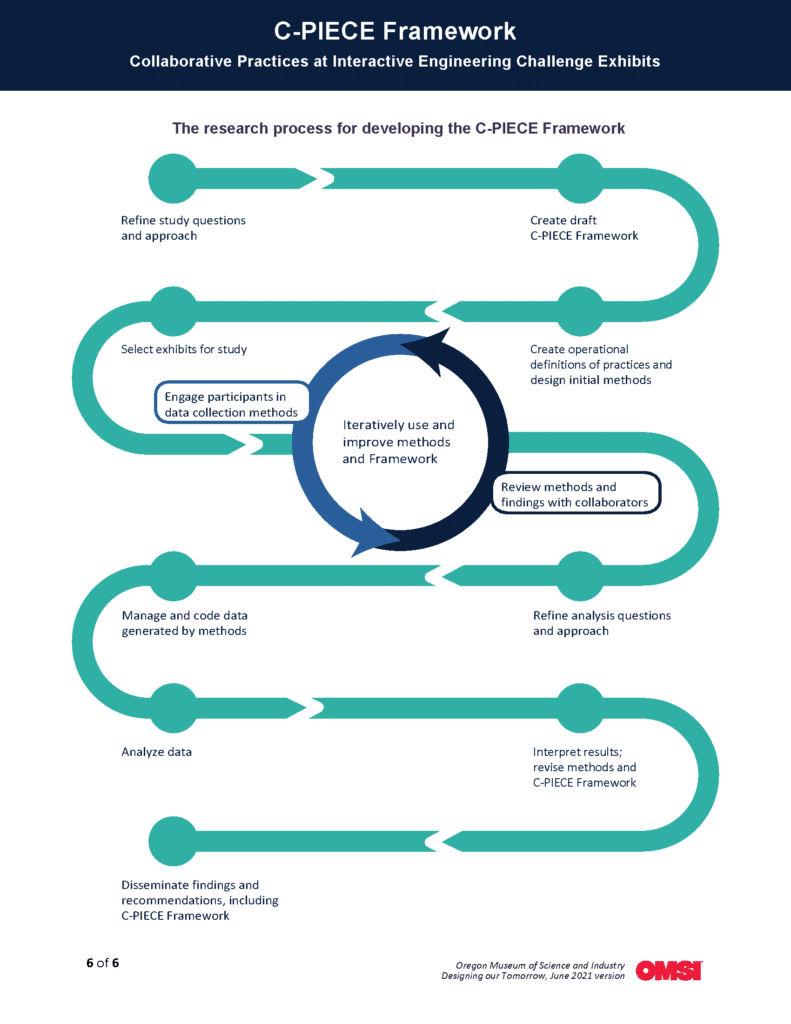Studying Engineering Proficiencies
To advance our understanding of how institutions can broaden participation of underrepresented groups and fill gaps to maximize innovation in solving future problems, this project included two research studies:
A study of collaborative practices at interactive engineering challenge exhibits (C-PIECE Study) developed integrated measures for several visitor experience outcomes including engineering proficiencies, intergenerational collaboration and visitor satisfaction. We employed culturally responsive approaches to data collection and analysis, in which the culture and context of the visitors are considered crucial facets in evaluating the study’s impact.
A study of conversation participants’ choices and connections on the topic of engineering practices and usefulness in day-to-day life (EP&UDL Study) utilized the C-PIECE framework and prioritized the centering of parent/guardian voices, co-development between parents and educators, and stories as a means to learn more about how adults communicate the DOT exhibit, specifically the exhibits’ relevance with regard to everyday engineering.
These studies build on prior work on engaging girls in STEM using altruistic, personally relevant and social experiences, and increasing bilingual exhibits that teach engineering proficiencies. By better understanding and promoting engineering learning in ISE, we will raise public awareness of sustainable engineering practices.
C-PIECE Study
The C-PIECE Study, A study of collaborative practices at interactive engineering challenge exhibits, was the first of two research studies in the the DOT research program.
In this study we explored engineering practices used by families engaging with design challenge exhibits, guided by one overarching question:
“What can we better understand about fostering engineering design practices associated with more informed levels of engineering proficiencies by improving engineering design challenge exhibits and facilitation for families?”
While the research did not proceed linearly — it involved reflecting, revising, and working on multiple aspects of the project simultaneously — it roughly followed this process:

The purpose of the C-PIECE Study was to develop theory-based measures of engineering proficiencies within an exhibit context. The investigation was guided by the following research questions:
- What instruments capture engineering proficiencies at exhibits? Specifically, what are valid approaches to assess visitors’ proficiency in (a) Defining a problem, and (b) Optimizing Solutions at exhibits?
- What is a valid method for determining visitor awareness of engineering process in an exhibit?
- What is a valid method for determining intergenerational collaboration?
The C-PIECE Study developed integrated measures for several visitor experience outcomes including engineering proficiencies, intergenerational collaboration and visitor satisfaction. We employed culturally responsive approaches to data collection and analysis, in which the culture and context of the visitors are considered crucial facets in evaluating the study’s impact. This included a culturally responsive framework specific to the project and strategies for data collection, analysis, interpretation, and dissemination.
EP&UDL Study
A study of conversation participants’ choices and connections on the topic of engineering practices and usefulness in day-to-day life (EP&UDL Study) looked at the storytelling choices parents and educators use to communicate to other parents and educators that the DOT practices in the exhibit are usefully relevant to engineering practices in families’ everyday lives and their community goals.
This study centered the voices of parents and guardians (caregivers) by having parents in roles to generate stories, respond to stories, and revise stories. Building on theories of relevance in education and the theory-based C-PIECE framework, caregivers helped develop a conjecture visualization and an evidence-based, contextual model of the types of strategies that might inform stories about the DOT exhibit’s connections to families’ everyday engineering practices.
The study reveals evidence that begins to show relationships between variables such as the content strategies in the stories and the perceived usefulness of DOT engineering practices mentioned in the stories. The study was designed to support stories that are part of ecological communications; not any one particular stereotype story. The approaches and model emerging from this evidence can inform many types of stories that are told about the value and usefulness of exhibits, such as between parents or between educators and parents.